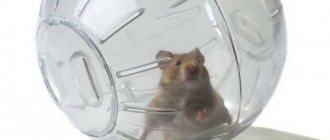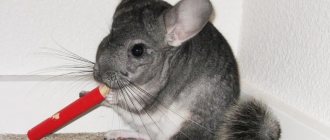Hamsters are small rodents that are well adapted to home conditions. There are several types. The most common ones include dzhungarik. These are small animals with a body length of 10-12 cm. Another species is the Syrian rodents with a pleasant golden skin. They are classified as large representatives of the species.
Hamsters are surprisingly nimble animals. At home, they either sleep in their cozy cage or quickly move around the room. In the wild, they are known to cover up to ten kilometers a day. Knowing about this feature, kind owners let the little animals out to walk around the house. However, this activity is unsafe, because hamsters are capable of chewing through furniture, hiding in a corner, etc. You may not notice a rodent on the floor and accidentally step on it, so it will be better if the owner purchases a special ball for the hamster.
What is a hamster ball?
Rodent Health Benefits
The ball will be convenient for the owners and useful for the pet.
Advantages of the accessory
The device has a number of advantages:
- Ensures the safety of the hamster. The owners will not step on it, cats or dogs will not attack it. The rodent will not get lost or run away even in the absence of constant supervision.
- Protection for home furniture. The animal will not be able to chew tables, chairs, sofas once outside the cage.
- Allow pets to roam around the apartment. Some hamster owners walk their pets in balls in their summer cottages and gardens.
- Suitable for carrying while going to the veterinarian. Can be used as a temporary house when the owners clean the cage.
- Allows you to keep your home clean. The ball itself is easy to wash, so the owners will not have any difficulty removing feces.
- Benefit for health. Jogging in a ball strengthens muscles and is suitable as physical activity for a rodent.
- Convenience for owners. After walks, the animal gets tired, after which it sleeps peacefully at night, without disturbing its owners.
The device ensures the safety of the hamster.
Disadvantages of a walking ball
The products have a number of disadvantages:
- Short service life. Plastic balls become unusable after just a year. Frequent use will cause the door latches to wear out faster.
- Low duration of use. You should not leave your pet inside for more than 20 minutes. If the hamster sits in the ball longer, its condition will worsen due to overheating and limited oxygen supply.
- Cover falling out in homemade structures. If the door opens, the pet may escape.
Precautionary measures
To make your walks safe, you must take precautions.
- The door must be well closed. If it becomes loose and opens spontaneously, this ball should no longer be used.
- There is no need to wrap the surface of the ball with tape for reliability. This can block the ventilation holes and the hamster will suffocate.
- The hamster should walk on a flat surface. Access to stairs and other height differences must be blocked.
- Do not let your hamster roam on tables, windowsills or other high surfaces from which he could fall onto the floor. Or use special barriers.
- There should be no cats, dogs or other large animals in the room where the rodent runs. Even if they don't touch the hamster, the pet will experience stress.
- There can only be one animal in one ball.
- Do not place foreign objects into the sphere.
And don't forget about cleanliness. After each walk, the accessory must be washed and dried well.
Requirements for a hamster ball
To ensure that the product does not harm your pet, you need to select the correct size ball. Consider the rodent's body length to determine the appropriate diameter. A sphere that is too small will not allow the hamster to accelerate, and a large one will be heavy and lead to pain in the paws due to excessive tension.
Consider ventilation products before purchasing. The more there are, the better. When running, the rodent will need a constant supply of fresh air. Otherwise, he begins to choke. In addition, the animal explores the world more by smell than by sight, and the holes allow odors to penetrate inside.
Check the quality of the door. The fastenings must be as reliable as possible so that the passage does not open while jogging.
Games in the cage
If there are other pets at home or you are worried about the safety of your home, you can diversify your pet’s leisure time with the help of special devices. Play complexes of different sizes and variations can be purchased at many pet stores or you can build them yourself.
Swing
By placing a plank on a round block, you can build a rocking chair. So that the hamster understands what needs to be done, place a treat on the opposite side. After a while, the animal will learn to balance and will have fun.
Football with a hamster
To assemble an improvised football field, just glue the cardboard into the shape of an ordinary box and cut a round hole (the size of a glass) on one side of the box. A glass with a cut out bottom is inserted into the prepared hole and secured with a glue gun. It will serve as the entrance to the box. After these simple steps, you can begin the most interesting part - decorative finishing of the football field. Green paper acts as grass here. It can be glued to the surface of the box with instant glue and decorated as desired. To assemble the gate, use white paper cut into thin strips. There are no special recommendations here; it all depends on the owner’s imagination.
To play, a soccer ball is placed on the field, near a glass. The hamster is placed in a glass from the outside. Passing through the glass, the animal involuntarily pushes the ball, and it flies into the goal. The game captivates hamsters and their owners for a long time, so it is quite popular.
Bottle maze for hamsters
Bottle maze is a fun game that won’t bore your furry pets for a long time. Creating equipment for it will not require much effort and time. Hamster owners will need several plastic bottles. Their size, shape and color do not matter (very small ones are not suitable, since the hamster simply will not fit into them). In addition, scissors and a glue gun (or bright, high-quality tape) will be useful for your work. To decorate the labyrinth, you can use any decorative elements: buttons, ribbons, corks, plasticine, rhinestones, beads, appliques.
To make a labyrinth, you must first draw a diagram, from which it will be clear in which places the bottles will be attached to each other. Next you need to make holes in the bottles according to the plan. Scissors, a utility knife, or any sharp cutter will be useful for this.
It is important that the diameter of all holes matches the diameter of the bottles inserted into them. And of course we must not forget that the labyrinth must have at least one entrance and exit.
After cutting, you need to insert all the bottles into each other according to the diagram and secure them with tape or glue. Almost done. All that remains is to decorate the labyrinth. There are no restrictions here. But, it is important to glue all the decor very securely so that the hamster cannot accidentally swallow it.
To complete the maze, the hamster is placed in one of the entrances, and then the owners only watch as their pet tries to find a way out. By the way, at the end of the tunnel, you can put your hamster’s favorite treat to reward him for a good game.
Cardboard box hamster maze
You can attach the walls of the future labyrinth so that the hamster runs between them, or you can make holes in them. The main thing is to make them big enough
It is important to understand that hamsters are active animals, so strength is very important when creating a maze. In addition, you need to make the walls high enough so that the pet cannot climb on them and break them.
The course of the game is not much different from the process of playing in the bottle maze.
How to choose a walking ball
When choosing, consider a number of criteria.
Size and its meaning
When choosing the right size, the hamster's back remains in a physiological position, and excessive stress is not placed on the legs.
It is important for your hamster to choose the right ball size.
Products come in 3 sizes:
- 12-13 cm. Made for Djungarian, Campbell, Roborovsky, Sungur and other small breeds.
- 18-20 cm. Suitable ball for Syrian hamster.
- 28-33 cm. Suitable for chinchillas, ordinary hamsters.
Colored or transparent
Vision in rodents is poorly developed. In order for your pet to see the room outside the walking device, it is better to buy a transparent one. If suitable products are not available, take light, yellow or green.
Bright shades are not suitable, since the animal will not distinguish the contours of objects through the walls of the sphere.
Is fastening necessary?
The mount is an additional accessory that allows you to secure the product to a stand. The fixed sphere prevents the rodent from running around the house. In this case, the hamster is subjected to physical stress, like in a wheel. Most often there is no need for such an accessory. It is recommended to buy it only if the rodent refuses to use the wheel installed in the cage and prefers a ball.
Is a stand needed?
The stand is an additional accessory designed to fix the ball in one place. There is no great need for this detail, but it can make trips to the vet or cleaning the hamster cage more convenient.
The stand fixes the ball in one place.
Model overview
If you are not sure which hamster walking ball is suitable for your pet, study the assortment in the store and consult with the seller. There are many good balls for walking hamsters, the price range is quite wide.
Here are some of the most popular models:
- Fun Bowl. Oval ball for Syrian hamsters. Larger diameter – 19 cm. Colorless transparent plastic. The trainer has 4 doors and 20 narrow ventilation slots. Cost 760 rubles.
- Super Pet. Round balls of various colors. They have 2 entrances and many holes for air circulation. The product is certified, non-toxic. The company produces balls for hamsters of different sizes. Thus, a toy for a Dzungarian (d = 12.7 cm) costs from 300 rubles, and for a Syrian (d = 18 cm) – from 490 rubles.
- Trixie. The round hamster ball is sold with a stand. A stable base in the form of a square. The toy is intended for Syrian hamsters (d = 18 cm). The body is transparent, colorless. Has 2 doors. The cost of the set including the stand is from 380 rubles.
- Credo. A ball made of transparent orange plastic for dwarf hamsters (d = 12.5 cm). There is only 1 exit, but the ventilation windows are evenly spaced. One of the cheapest models, costs about 200 rubles.
- Savic for dzungarians and Roborovsky hamsters (d = 12 cm). 2 entrances, round and slot-shaped ventilation holes. Price – 330 rubles.
- Georplast for small breed hamsters (d = 12.5 cm). A very stylish toy, made in the shape of a globe. The stand is stable. There are 2 entrances to the ball, ventilation is excellent. Cost – from 420 rubles.
A correctly selected ball will help the animal explore the world and keep itself in good shape. But for this, the khoma needs to be taught how to use the simulator.
Varieties of walking balls for hamsters
There are several options for a hamster accessory. Classic spheres allow the animal to run in any direction. If owners do not want their pet to move chaotically around the apartment and want to make its route predictable, a ball with a track will suit them.
With or without stand
Balls without a stand cannot be fixed. The hamster will be able to run around the whole house in them. If the owners do not want the pet to disturb guests or run away during a visit to the veterinarian, it is better to take a product equipped with a stand.
Ball materials
Only lightweight plastic spheres are suitable for hamsters. Metal and wood are too heavy for rodents. In addition, they limit the view. The pet will constantly bump into obstacles while inside such a container. Glass is not suitable as a material due to its fragility. If the ball breaks, the hamster may be injured. Be sure to check whether the plastic is toxic. Even a small dose of toxic substances can lead to the death of a small animal.
Hamster balls are made of plastic.
With or without fastening
Fasteners are needed to secure the door. They make the product safer, but may impair mobility. The owners personally decide whether they need this accessory.
Advantages
The hamster ball allows the baby to safely move around the apartment - the rodent will not fall anywhere, fail, or get hurt, and also does not cause damage to the apartment. After all, if you let your baby “free swim”, he can chew on wires, things, hide securely and cause other inconveniences.
Not every hamster breeder knows how to teach a hamster to run in a ball, but if you do this, the baby will be able to expand its boundaries, exploring not only fenced areas - a bathtub, a playpen, but also your entire home. Many hamsters like to walk in a ball, but for safety reasons, do not leave the baby in it for long. All household members should know about walks so as not to accidentally step on them.
The main advantage is that the pet will be able to visit all areas of the apartment without causing damage to property.
An important issue is cost. The product is freely available and inexpensive. Of course, you won’t find a ball for a Djungarian hamster for a ruble, but for 150-200 rubles, that’s enough!
Important: walking balls are available in a wide range, but you need to choose the one with the most air holes.
Features of using balls for walking
To protect your pet, follow the rules for using walking spheres.
Security measures
Follow safety precautions to avoid harming your hamster:
- Keep track of the length of your walks. Do not let your pet run around the apartment for more than 20 minutes. Otherwise, due to a lack of oxygen, the rodent will feel unwell.
- Carefully place the animal inside. Close the door tightly. Make sure that the passage does not open, as the hamster may run away or get lost.
- Do not leave the ball on tables or shelves. A fall can lead to injury and death of the rodent. Carefully lower the sphere to the floor. Protrusions and stairs along which the ball can roll should not be accessible to the pet.
- Keep dogs, cats, and small children away from the walking area. Having become interested in a toy, they can start rolling and kicking it. As a result, the hamster will be injured.
- Do not push the sphere to speed up the rodent. Such an action will cause stress and scare the animal. The rodent must move its vehicle independently at an appropriate pace.
- Do not put several individuals in one ball. Hamsters can suffocate due to lack of oxygen. For each individual, purchase a separate toy.
- Be careful when letting your pet go for a walk. Be careful not to accidentally kick the ball. Even a slight push can become stressful for a hamster. A strong blow to the toy will cause injury to the rodent.
To avoid harming your hamster, watch his walk.
How to teach to ride
Hamsters should be accustomed to a new vehicle gradually. The first time, place the rodent inside for just 1-2 minutes. Then start increasing the duration of your walks. Monitor the animal's reaction to the innovation. If the hamster is afraid or has a negative attitude towards the ball, stop using it. Stress will only harm your pet and shorten its lifespan.
To provoke interest in the sphere, place a treat inside: a piece of apple, pear or other permitted fruit. The rodent will climb into the ball to get a treat. Once it is inside, lightly rotate the product to show the animal how the new toy works. Make all movements slowly, smoothly, avoid sudden loud sounds. Noise and threats will cause stress and reluctance to continue learning.
Please be patient. Do not rush the animal, take into account its individual characteristics. Eliminate stressors when studying. Warn children not to make noise, scare the hamster, or speak loudly until the pet gets used to the ball. Do not allow cats or dogs into the room. They look larger from the plastic container.
Seeing the head of a predator, the hamster will get scared and may completely refuse to use the toy for walking.
Flaws
When buying a ball for your hamster, make sure it is well ventilated. The baby can spend no more than 15 - 20 minutes inside, otherwise he may suffocate - during the run, the walking ball heats up, and little air gets in - as a rule, the accessory is equipped with several small holes. There are cases where rodents remained inside the ball for several hours, as a result of which they died. This happened for various reasons, but mainly due to overheating and lack of air. During this time, the animal may be overcome by thirst or a feeling of hunger, but it cannot leave the “imprisonment” on its own.
The hamster in the ball fulfills its physiological needs, which, while running through the ventilation holes, scatter throughout the apartment - you will have to clean up. One more nuance: during use, the fastenings wear out, so one “fine” day the hamster’s ball may simply fly apart during a walk and the animal will set off into free swimming.
Pros and cons of a homemade walking ball
The main advantage of homemade toys is the owner’s attention to the pet. A person wants to show love to an animal in this way.
Making a round ball yourself is difficult.
Such products, however, have a number of disadvantages. It is difficult to make a round product yourself. More often the container turns out to be oval. The hamster in it is forced to run back and forth. The animal will not be able to move forward. Owners often have difficulty cleaning the inside of the product.
It is difficult to make a high-quality toy at home. Homemade spheres are more likely to break and cause escape or injury to your pet. There is no big difference in price. In a veterinary store you can purchase ready-made products for 60-100 rubles.
What is the difference between the white Syrian hamster and the rest?
The white Syrian hamster has no fundamental differences from Syrian hamsters of other colors. At the same time, white coat color is less common than others. White hamsters have all the characteristics of albino animals, such as red eyes. This makes it easy to distinguish it from rodents with cream fur and ordinary gray eyes.
In fact, all care for hamsters comes down to feeding, adding water to the drinking bowl and cleaning the cage (2-3 times a week). The cage should be lined with a thick layer of sawdust, equipped with a wheel, drinking bowl and feeder. Every day, new water is added to the animal and food is given (preferably at the same time). Woolen threads, cotton wool and straw should not be used as bedding for the cage.
The hamster must be periodically released from the cage to walk around the apartment. It is advisable to teach him from childhood not to be afraid of human hands and presence. Having become accustomed to its owner, the Syrian hamster remains tame and docile throughout its life.
The favorite food of Syrian hamsters is boiled cereals, milk, pasta and wheat bread. A complete diet for a hamster is impossible without vitamin supplements and boiled meat.
In this regard, domesticated hamsters, which to this day have partially retained the habits of their ancestors, are kept alone, with the exception of cases when the female is briefly allowed into the male’s cage for reproduction. If you let a male into a female’s cage, the female partner is unlikely to show him favor. At such moments, you need to look after your pets in order to have time to break up their fight, the likelihood of which remains in any case.
Wild Djungarian hamsters live in families, which means it is permissible to keep several hamsters in one cage. It is advisable to keep them in pairs, seeding the grown-up cubs. The spaces between the bars of the cage should be narrow so that small hamsters cannot escape. Djungarian hamsters need to be handled and fed every day, otherwise the rodent will no longer recognize the owner and will again become wild and nervous.
Syrian and Djungarian hamsters are white
How to make a walking ball for a hamster with your own hands
There are several ways to make a walking sphere with your own hands.
From an old lampshade
Since the diameter of the lampshades does not exceed 13-15 cm, the product is suitable for Djungarian or young Syrian hamsters. Choose a round transparent or translucent product. Make a round hole in it the size of your pet. Save the cut plastic, it will become a door for the toy. Using a drill, make 5 air holes in the lid.
Throw your hamster inside. During the walk, tape the door so that the rodent cannot leave the toy on its own. The disadvantage is the low quality of the disposable fastener.
From a plastic bottle
Take a 1 liter bottle with a wide neck. For large varieties, you can take a five-liter container. Rinse and dry the bottle. Remove the label so as not to interfere with the animal's exploration of the area outside the toy. Make several long narrow cuts for air access. The more holes there are, the better for the pet. Throw your hamster in through the lid. Be sure to tighten tightly to prevent escape.
Types of running wheels for hamsters
Hamsters of different breeds can be very tiny, from 4.5 cm to large individuals reaching 34 cm in length. Accordingly, some are lighter, others are heavier. Depending on the type of your hamster, you should select a running wheel for your pet.
Which wheel you choose for your hamster’s home will depend not only on its health, but also on its safety. Agree, if you buy a small wheel for a large hamster, and a huge one for a miniature one, then your animals will not be able to run on this simulator.
So the first thing you need to do is decide on the diameter of the running wheel.
For example, for Djungarian hamsters or for a Syrian baby, the diameter of the wheel should be a minimum of 14 cm and a maximum of 16 cm.
An adult Syrian hamster needs wheels more than 18 cm in diameter.
The track in the wheel must be of sufficient width. If its width is not enough, the hamster may fly out of the wheel. For example, for miniature dwarf breeds, a width of 5 cm will be enough, but for Syrian hamsters, the width of the wheel should be at least 7 cm.
The trainer should be the size of your rodent. If you have not chosen the correct diameter of the treadmill, then your baby will squeeze, stumble and get injured in the small wheel. It's hard for kids to run in a wheel that's too big. They have difficulty rotating it and, as a result, will stop using it altogether.
Not only the comfort of your hamster, but also the health of your pet depends on a correctly selected wheel. The consequences of incorrectly purchased running wheels can be sad. Spinal injuries, dislocations of limbs and even fractures are possible.
Running wheels are:
- plastic;
- metal;
- wooden;
- combined.
One of the disadvantages of metal running wheels is that they tend to squeak over time. Considering that your animal loves a nocturnal lifestyle, it will train in its wheel at night. Your sleep and a squeaky wheel don't go well together, would you agree?
The plastic running wheel is quiet and comfortable enough for a hamster to run. The main thing is that the treadmill has small ribs that the little athlete can cling to and not slip off.
Running wheels made from a combination of plastic and metal materials have proven themselves. The wheel itself is made of plastic, and the stand is metal. This is a silent and lightweight design with a reliable metal support.
Basically, lattice, mesh and wooden running toys for hamsters are common. If the wheel has a metal mesh, then the cells should be small so that the furry paws do not fall into them.
Important! The gap between the rotating working part of the surface of the simulator and the fastening of the wheel stand axle must be more than one centimeter. Otherwise, the hamster risks cutting off its leg, as the limb may get stuck in a narrow space, in which case the “scissors effect” is obtained.
The only negative is that from time to time the hamster can sharpen its teeth on its treadmill, but this will not cause any harm to its health.
Methods for attaching running wheels
- Hinged - screwed with special fasteners or ordinary wire to the cage lattice. This option is suitable for small cells. During hamster training, there may be sounds of the wheel tapping on the mesh of your pet's home.
- Floor-standing - these wheels stand on a floor stand and fit well into a spacious cage. The main disadvantage is that they are not entirely stable.
- On a stand with floor mounting - this method of mounting is more reliable. The stand attaches securely to the cage floor. This is the safest simulator.











